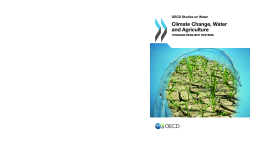
BOOK
Climate Change, Water and Agriculture
(2014)
Additional Information
Book Details
Abstract
This report analyses the adaptive capacity in agricultural water management, adaptation in agriculture to water variability and extreme events, (floods and droughts), mitigation, (water and energy) and uncertainty about further climate change.
Table of Contents
| Section Title | Page | Action | Price |
|---|---|---|---|
| Cover\r | Cover | ||
| Table of contents | 5 | ||
| Executive summary | 7 | ||
| Chapter 1: Impact of climate change on the water cycle and implications for agriculture\r | 11 | ||
| Impact of climate change on the water cycle | 15 | ||
| Precipitation and surface water | 15 | ||
| Glaciers and snow | 16 | ||
| Groundwater sources | 16 | ||
| Water availability and agricultural production under climate change | 17 | ||
| Impacts on crop water requirements | 17 | ||
| Impact on crop yields | 18 | ||
| Impacts on livestock production | 20 | ||
| Climate change effects on livestock | 21 | ||
| Water quality and agriculture under climate change | 23 | ||
| Agricultural water availability constrained by reduced water quality | 23 | ||
| Water quality changes due to changed agricultural production practices | 23 | ||
| Climate change and extreme water events: Droughts and floods | 24 | ||
| Droughts: Past trends and projected impacts on agriculture under climate change | 28 | ||
| Floods: Past trends and projected impacts on agriculture under climate change | 30 | ||
| Other extreme weather events | 30 | ||
| Remarks on extreme climate events | 31 | ||
| Summary | 32 | ||
| References | 34 | ||
| Chapter 2:\rClimate change adaptation and mitigation strategiesfor agricultural water management | 45 | ||
| Adaptation policies for agricultural water management: An economic framework | 46 | ||
| The features of the adaptation problem: uncertainty, long-term and complex interactions | 46 | ||
| The purposes of adaptation strategies: Reducing vulnerability, increasing resilience | 48 | ||
| Economic rationale for government policy intervention in climate change adaptation | 49 | ||
| The different levels of action for the adaptation of agricultural water management to\rclimate change | 51 | ||
| On-farm adaptation of water management | 51 | ||
| Reviewing the main adaptation options for agricultural water management | 51 | ||
| Drought-resistant varieties | 52 | ||
| Adjusting planting times | 52 | ||
| Irrigation | 53 | ||
| Shifting crops and new cropping areas | 54 | ||
| Combining farm practices in a holistic agronomic approach | 54 | ||
| Knowledge gaps and surprises: Pests, diseases and weeds, pollinators | 55 | ||
| Public policies fostering on-farm adaptation of water management | 57 | ||
| Water management policies for adaptation at the watershed level | 57 | ||
| Risk management approaches for adapting to increasing risks of droughts and floods | 63 | ||
| Insurance and compensation policies against droughts and floods | 63 | ||
| Innovative risk-sharing tools | 64 | ||
| The need for a holistic approach for managing weather risks under climate change | 65 | ||
| Agricultural policy coherence and the role of market drivers | 67 | ||
| Market drivers, price signals, and international risk-sharing | 67 | ||
| Policy sequencing: Fostering an enabling policy environment for adaptation | 68 | ||
| Interactions between mitigation and adaptation of agricultural water management | 69 | ||
| Summary | 73 | ||
| Notes | 74 | ||
| References | 75 | ||
| Chapter 3:\rConclusion and key policy implications | 79 | ||
| Glossary | 83 | ||
| Glossary references | 85 | ||
| Annex A.\rLinkages between climate change, water and agricultural production | 87 | ||
| Annex B.\rTrends in temperature anomalies | 89 | ||
| Annex C. A review of the water resource and water quality implications\rof selected mitigation practices | 91 | ||
| Direct land use change | 91 | ||
| Crops to pasture | 91 | ||
| Crops to forest | 91 | ||
| Marginal and pasture lands to crops and bioenergy | 92 | ||
| Agricultural management practices | 92 | ||
| Tillage practice | 92 | ||
| Crop mix and perennials | 92 | ||
| Irrigation management | 93 | ||
| Fertiliser management | 93 | ||
| Chemical use reduction | 93 | ||
| Manure management | 93 | ||
| Breeding and animal species choice | 93 | ||
| Bioenergy | 95 | ||
| Liquid fuels | 95 | ||
| Electricity | 95 | ||
| Pyrolysis – Biochar | 95 | ||
| Feedstocks: Conventional crops and their residues | 96 | ||
| Feedstocks: Energy crops | 96 | ||
| Animal wastes | 96 | ||
| Processing by-products | 96 | ||
| Annex references | 97 | ||
| ORGANISATION FOR ECONOMIC CO-OPERATION\rAND DEVELOPMENT | 100 |
